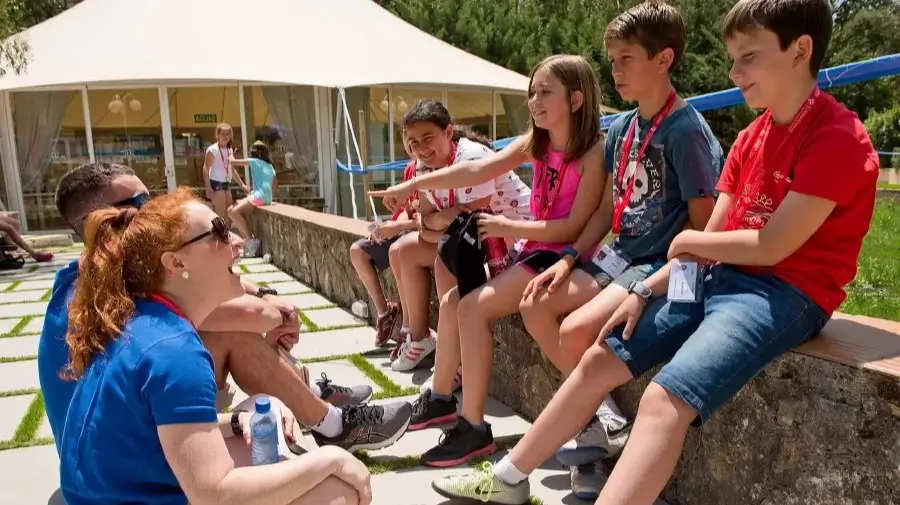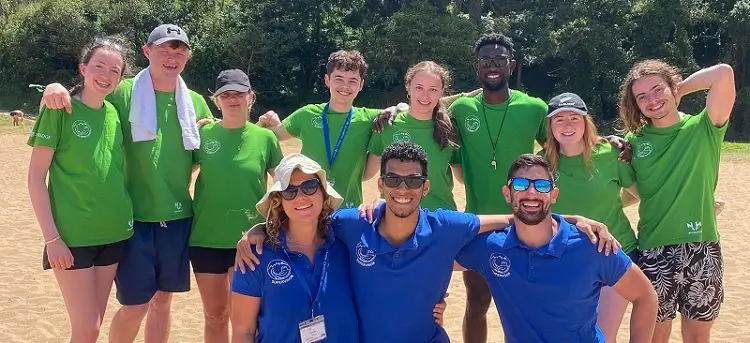Every summer, thousands of families look for an English camp where their children can improve the language while enjoying new experiences. However, not all programs deliver what they promise. Many parents discover, too late, that what seemed like immersion was actually just a course with a few hours of class and activities in Spanish. The result is frustrating: the child has fun, but barely practices English.
The key is to distinguish between a camp that simply adds English to its schedule and one that turns it into the language of coexistence, play, and learning. A truly immersive camp is not measured by the number of class hours, but by how the language is lived throughout the entire day. And although it may seem difficult to identify, there are clear signs that will let you know if a camp ensures full immersion or if it only offers summer classes disguised as immersion.
What a truly immersive English camp means
When we talk about an immersive English camp, we don’t mean a place where children attend a few hours of class a day and then go back to speaking Spanish. Real immersion happens when the language becomes the main tool for living together, playing, and learning all day long.
In a camp of this kind, English is present from the moment children wake up until they go to bed: at breakfast, in the instructions for a football match, during theater rehearsals, or on a nature excursion. It’s not about teaching isolated vocabulary, but about creating an environment where participants think and express themselves in English because it is the common language.
This approach has several advantages compared to traditional classes:
- The language is associated with fun and social moments, not obligation.
- Children gain fluency because they are motivated to communicate at all times.
- Constant practice reduces embarrassment and the fear of making mistakes.
- Learning happens naturally, without the need for books or exams.
An authentic immersive camp, therefore, is not measured by the number of classes included in the program, but by the number of hours per day in which English becomes the real language of interaction.
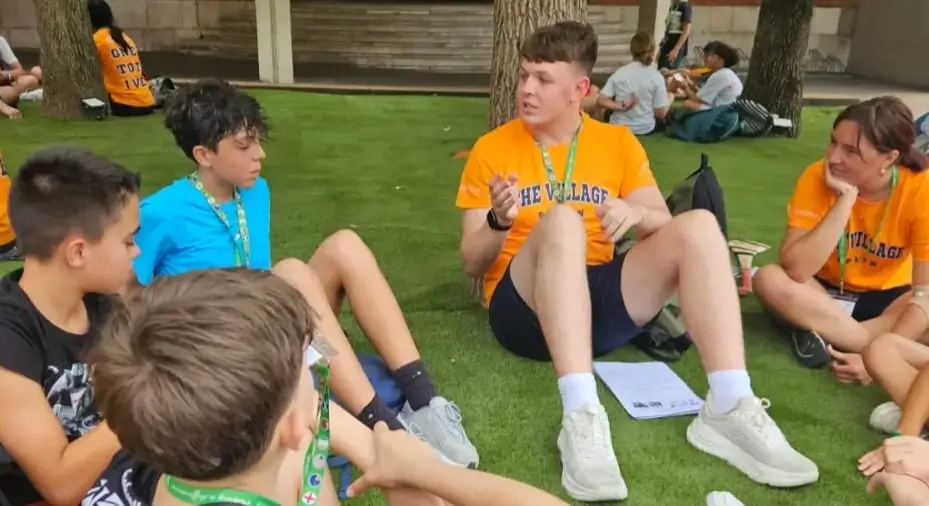
Signs that a camp is not immersive
Although many programs present themselves as “English camps,” not all guarantee true immersion. In fact, it’s common for some programs to use the language only as a marketing hook. These are some signs that should raise red flags for parents:
Only classes instead of activities in English
If English is limited to a couple of hours of daily classes, while the rest of the time activities are carried out in Spanish, we are not talking about an immersive camp. It is more like a traditional summer course with a bit of leisure added.
Children communicate in Spanish
In camps where most participants speak the same language and a multicultural environment is not encouraged, it’s common for children to keep interacting in Spanish. The result is that they hardly make an effort to use English to communicate.
Few native or international coaches
If the coaches are not native or international, and most interactions happen in Spanish, exposure to English is drastically reduced. A true immersion camp needs a diverse and prepared team to maintain the language as the main vehicle of communication.
Children return with little conversational practice
A clear sign that the camp was not immersive is when children come home without having gained fluency. They may have learned new vocabulary in class, but they didn’t put it into practice in real-life contexts of coexistence.
Recognizing these signs before booking helps families make informed decisions and avoid experiences that do not meet expectations.
Characteristics of a camp that guarantees real immersion
A truly immersive English camp shares a series of characteristics that set it apart from programs that only include a few classes. These are the key aspects that ensure children live the language at all times:
100% activities in English
True immersion occurs when all activities—sports, arts, excursions, and social life—are carried out in English. It’s not about “adding” one class per day, but about turning every experience into an opportunity to communicate in the language.
Native and international coaches
The human team is the foundation of immersion. A camp with international, native, or qualified bilingual coaches ensures that English is the working language in all interactions. In addition, it exposes children to different accents and cultural expressions.
Multicultural environment that motivates communication
Living with children from different nationalities multiplies the motivation to use English as the common language. In a multicultural setting, Spanish is no longer enough to communicate, and children naturally make an effort to express themselves in English.
Small ratio for personalized attention
An immersive camp also pays attention to the number of participants per coach. Small groups facilitate constant interaction and ensure that each child receives the attention needed to feel confident and participate actively.
At The Village, all these aspects are present: more than 200 hours of English in just 15 days, a team with 80% international coaches, a close ratio of 1 coach for every 5 participants, and living together with young people from over 12 nationalities. Every activity—from surfing to musical theater—becomes an opportunity to practice English naturally and enjoyably.
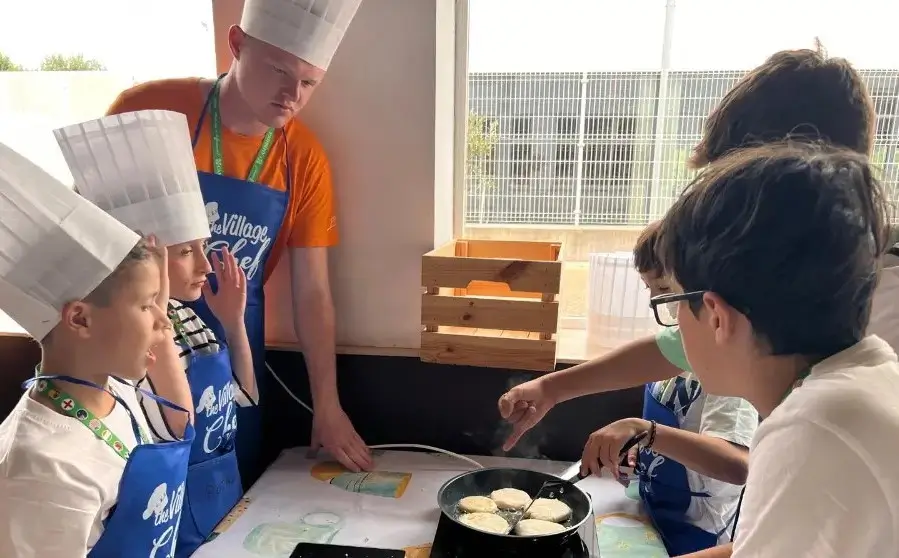
Benefits of full immersion versus traditional classes
The difference between a camp that offers English classes and one that ensures real immersion is not only a matter of method, but also of results. When the language is lived throughout the entire day, learning is deeper, faster, and much more motivating.
Much faster oral fluency
In an immersive environment, children have no choice but to communicate in English. From asking for materials in a workshop to organizing themselves in a football match, the language becomes part of daily life. This accelerates oral fluency much more than any intensive course.
Useful and everyday vocabulary
While in traditional classes academic or isolated vocabulary is learned, in full immersion words and expressions that children use in their daily lives are internalized. This practical usefulness makes them remember the language better and apply it with confidence.
Confidence in speaking without fear of mistakes
Mistakes stop being a problem and become part of the process. By living in English, children lose their embarrassment and discover they can make themselves understood even without mastering every word. This strengthens their linguistic self-confidence.
Positive and motivating experience
When English is associated with fun moments—a match, a theater rehearsal, a trip to the beach—children experience it as something natural and not as an academic obligation. This positive association multiplies the motivation to keep learning after camp.
A fully immersive camp offers, in just two weeks, a linguistic experience equivalent to months of traditional classes. And most importantly: children return home not only with a better level of English, but with memories and friendships that reinforce their motivation.
How to identify a camp that delivers on its promises
Many families feel unsure because all camps seem to promise the same: “English all day.” The difference lies in knowing how to ask the right questions and cross-check information before enrolling a child. These are the aspects worth reviewing:
What percentage of the day is in English?
A serious camp can give a clear and measurable answer. If it’s not specified or they only talk about “a few hours of class,” it’s probably not full immersion.
Who are the coaches and what is their training?
The team of coaches is the central piece. Ask if they are native or international, what percentage they represent, and what experience they have in teaching and working with children and teenagers.
Are there children from other nationalities?
A multicultural environment forces the use of English as the common language. If the camp only gathers Spanish-speaking children, it’s difficult to guarantee true immersion.
How is learning organized?
A real immersion camp doesn’t need traditional classes or exams. English is learned through sports, workshops, social life, and creative projects. If the approach is academic, it’s more a course than a camp.
At The Village, all these questions have clear answers:
- More than 200 hours of English in two weeks.
- A team with 80% international coaches.
- Living together with young people from over 12 nationalities.
- Experiential methodology, no classes or exams, supervised by Cambridge University Press & Assessment.
Objective data like this are the best proof that a camp delivers what it promises and doesn’t stop at an empty slogan.
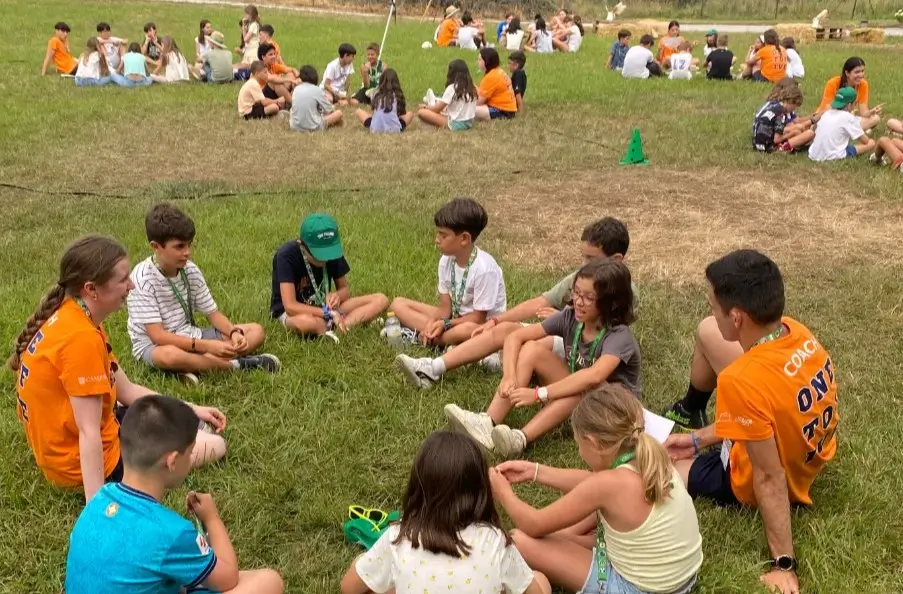
The Village as an example of real English immersion
In a true immersion camp, English is not studied, it is lived. That is the philosophy of The Village, where every detail is designed so that children learn naturally while enjoying an unforgettable summer.
For two weeks, participants live together in an international environment where English is the common language. The program ensures more than 200 hours of language exposure, with a team made up of 80% international coaches and a close ratio of 1 coach for every 5 children, allowing for personalized follow-up.
The methodology is clear: there are no classes or exams. Learning happens on the football field, in the theater academy, in a tennis match, or on a mountain excursion. Moreover, living with young people from more than 12 nationalities turns every interaction into a real opportunity to gain fluency and confidence in English.
That’s why, when parents look for a camp that offers real immersion and not just hours of class, they find in The Village the peace of mind of choosing a safe, motivating, and effective experience.
Choosing an English camp is much more than finding a place where your child spends the summer. It is deciding what kind of experience will shape their relationship with the language and with life away from home. A program with real immersion not only improves their level of English, but also gives them security, confidence, and memories that will accompany them for a lifetime.
Children learn better when they have fun, and they enjoy more when they feel part of an authentic and multicultural environment. That is the real difference between a camp with isolated classes and a camp where English is lived at every moment of the day.
If you want your child to discover that learning English can be as natural as playing, doing sports, or making new friends, the answer lies in a real immersion camp.

